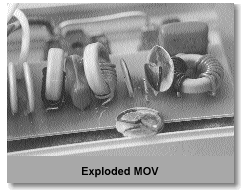
(Quick
Question Form)
IS A BRICK WALL THE BEST SURGE PROTECTION
YOU CAN BUY FOR YOUR AUDIO/VIDEO SYSTEM?
We've been doing this for a while and as far as we can tell the answer is an unequivocal;
yes.
To understand that the above statement is more than just advertising
rhetoric you will need a little working knowledge of an electronic
component call a Metal Oxide Varistor (MOV).
MOV's are the
universal, de facto standard surge protection component. Just about
every manufacturer of a surge protection product uses MOV's as the
lynchpin of their design. Thousand plus dollar audio power conditioners
do not break this rule. OK... so what are the who's, what's and
where's of the MOV? |

|
MOV's ARE INEXPENSIVE
The standard design calls for three of these components. Some
manufacturers will double up on them to offer a degree of redundancy
(you'll understand in a minute). More often than not they use the 14mm
size. The top of the line for point of use protection would hopefully
use the 20mm MOV. As stated before; "if you wanted to make a standard
outlet strip a surge protection device it would cost literally less
than 50 cents." If you used the 20mm... maybe a dollar. For the
manufacturer it would be even less, they buy in bulk.
MOV’s: SACRIFICIAL BY DESIGN
|
MOV’s are the mainstay component of the surge suppression industry. For
certain electronic applications
they are an excellent choice. AC power line surge suppression is not
one of them. MOV’s function by
creating a short circuit (usually to the neutral and the ground) when a
preset voltage threshold is exceeded.
Essentially they divert surge current away from what is being
protected. Unfortunately MOV’s are sacrificial
components. This means that the
performance life of any surge protection device utilizing this
technology is finite. With every surge current diversion above a modest level an MOV comes closer to its inevitable end. |
JOULE RATING/SURGE CURRENT LIMITATIONS
The joule rating of any MOV is a measure of the amount of energy it can
absorb at one time without failing. With an MOV this level declines
with use.
When exceeded it can cause an explosion or a fire. In a harsh, lightning
prone environment this limit can easily be reached. Our massive
inductor limits current (hence voltage) and has no real
world surge current/joule rating limitations. The product
can withstand the harshest surge environment
indefinitely.
THERMAL RUNAWAY (FIRE)
Clamping threshold is the voltage level where the MOV activates.
Typically it is set around 220V at 1 milliamp current. With the peak of
the sine wave normally at 172V, a surge of only an
additional 50V will activate that MOV. Just as repeated usage causes
the joule limit of an MOV to drop it can also cause the
clamping level to do the same. Eventually the clamping point can fall
below the peak of the normal sine wave. In essence the MOV turns on
with every cycle of the powerwave and experiences thermal runaway
(fire). This characteristic of an MOV made them totally unacceptable to
our engineers. Our surge protection products do not
utilize MOV’s and have none of their inherent limitations. Brickwall
Surge Filters will not catch on fire.
SO, MOV BASED SURGE PROTECTION UNITS...
are prone to failure, have problems with large surges and can catch on
fire or explode. We would assume that a thousand dollar audio powerline
conditioner that utilizes this technology would use 20mm MOV's, double
them up and provide a thermal fuse to protect against fire. We really
don't know. If we were you we would definitely ask. Even if they do the
protection they provide is still lacking. However there is
an alternative
SERIES MODE SURGE PROTECTION: TESTED BY UL TO ONE THOUSAND SURGES OF 6000V, 3000A
We believe that a surge protection device should not fail. At the heart
of our Series Mode Surge Filter is a massive inductor. This is not a
sacrificial component. It will never fail. It will not
degrade with use. In fact no component used in the construction of this
product is sacrificial. A Brick Wall Surge Filter will never experience a surge related failure.
You do not have to take our word for it. Consider the following:
- IEEE
(The Institute of Electrical and Electronic Engineers) states that
6000V is the largest transient that the interior of a building would
experience.
- IEEE
defines its harshest interior surge environment as one that could
experience 100 surges of 6000V, 3000A in a years time (category B3).
- A
new federal guideline recommends that a surge protector utilized in a
harsh environment should be capable of withstanding 1000 surges of
6000V, 3000A or ten years worth of IEEE’s category B3.
- UL
(Underwriters Laboratories) now provides a new adjunct testing service
(in addition to the 1449 safety classification) that will test to the
1000 surge, 6000V, 3000A federal protocol.
Passing such a test is a virtual guarantee that a surge protection device will never experience a surge related failure.
Early in 1996 UL applied 1000 surges (at 60 second intervals) of 6000V,
3000A to an off-the-shelf Series Mode Surge Filter.
There was no failure. There was no performance degradation. Let through
voltage did not exceed 290V. Certified by UL.
You cannot do any better than this for a point-of-use surge protection device.
|

![]()
